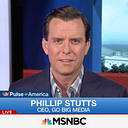The Moonshot Chapter 6— Going For It
A long road was ahead but for the first time I had hope and purpose.
This year I was inspired to take massive action in an effort to be cured of my disease, Achalasia, in five years. This is a multi-series blog on my fight. Click here to read my other posts.
I returned home in early February 2017 from the Abundance 360 conference and following my talk with Dr. Neil Riordan, I was cautiously optimistic.
After six years of living with Achalasia, I’d taken control of my condition and stopped thinking my doctors were just going to figure it out for me. A long road was ahead but for the first time I had hope and purpose.
I immediately conducted a conference call with the Stem Cell Institute and discussed the options they offered. One of my concerns was the risk stem cell injections could pose. The advisors made a point of explaining that there is no real health downside to undergoing stem cell treatments. I was told the downside is that the treatment may not work, but it won’t cause health problems for me. The real outcome was to get the stem cells into my damaged and surgically shredded esophagus with the hope that it would repair the nerves and muscle and work again (after six years).
The SCI was offering to use stem cells from a donor’s umbilical chord. Since no one had ever been treated for Achalasia at this clinic, they were recommending that I take the injections intravenously (they had no option to surgically injected stem cells into my esophagus).
A part of me thought, “What the hell do I have to lose? It’s safe and either it works or it doesn’t. It’s expensive but it’s also my life.” I’m also reminded of a Wayne Dyer quote that states, “Go for it now, the future is promised to no one.”
I began discussing the situation with my mentor and friend, Chad Cooper. He suggested I not rush into anything, gather as much information as possible, and consider talking to other doctors that understood stem cells. He suggested I meet with his friend, Bart Rademaker, a doctor out of Tampa, Florida that is also a surgeon at the Okyanos Cell Therapy Clinic.
Much like the Stem Cell Institute (in Panama), Okyanos Cell Therapy operates as an overseas (Bahamas) stem cell clinic, but with a different twist; they don’t use a donor’s umbilical chord stem cells to treat patients, they use your own fat, taken from the stomach (extracted via liposuction). The doctors at the OCT were American too, flown in from various states, to treat patients.
Dr. Rademaker is an amazing, caring physician — I was blown away by his attention, questions and focus on what was best for my health. He immediately assembled a medical team and we began conference calls to discuss my disease, thoughts on treatments, and what options were best for me.
The two stem cell clinics were both very credible but each treated patients differently. Common sense said that it would be more effective to have the stem cells surgically injected into my esophagus, rather than taken intravenously. I also liked the idea that my own stem cells would be used to treat my damaged esophagus, rather than a donor’s stem cells. This thought-process was made by my own intuition and nothing else.
Soon thereafter, Dr. Rademaker and his team identified an American gastroenterologist willing to discuss stem cell surgical options with me. Within a few days I was on the phone with this surgeon and his honesty was refreshing. He was willing to take steps forward with me, but he had no desire to rush into this without checking every box possible.
Things were moving fast and I’m not going to lie, it was exciting. But I also listened to the surgeon and Dr. Rademaker. It was important to take a deep breath and be cautious and patient. I wasn’t facing any imminent health situations, so why not evaluate my options and ensure my health and safety came first?
By the end of February, I made the decision to put the Stem Cell Institute option on hold and slowly go forward with Dr. Rademaker and the Okyanos Cell Therapy Clinic.
It’s also when the idea came to me to document my story by writing about it. My thought process was to “rattle the trees” to see if anyone out there would read it and provide additional insight or help. I knew I needed the exposure to open new doors and I felt extremely blessed when Inc. published my moonshot story on March 1, 2017.
Within a week of the article coming out, I received a voicemail at my company from an Achalasia researcher and advocate. This kind and caring soul would soon become a lifeline for me that I never expected.
Phillip Stutts is founder & CEO of Go BIG Media, Inc., an award-winning media firm serving corporate and political clients around the world. He founded Go BIG Media on an ethos of service, excellence, and generosity, and with a mission to totally disrupt an industry. He is sharing his personal breakthrough to help you to take your own moonshot.
